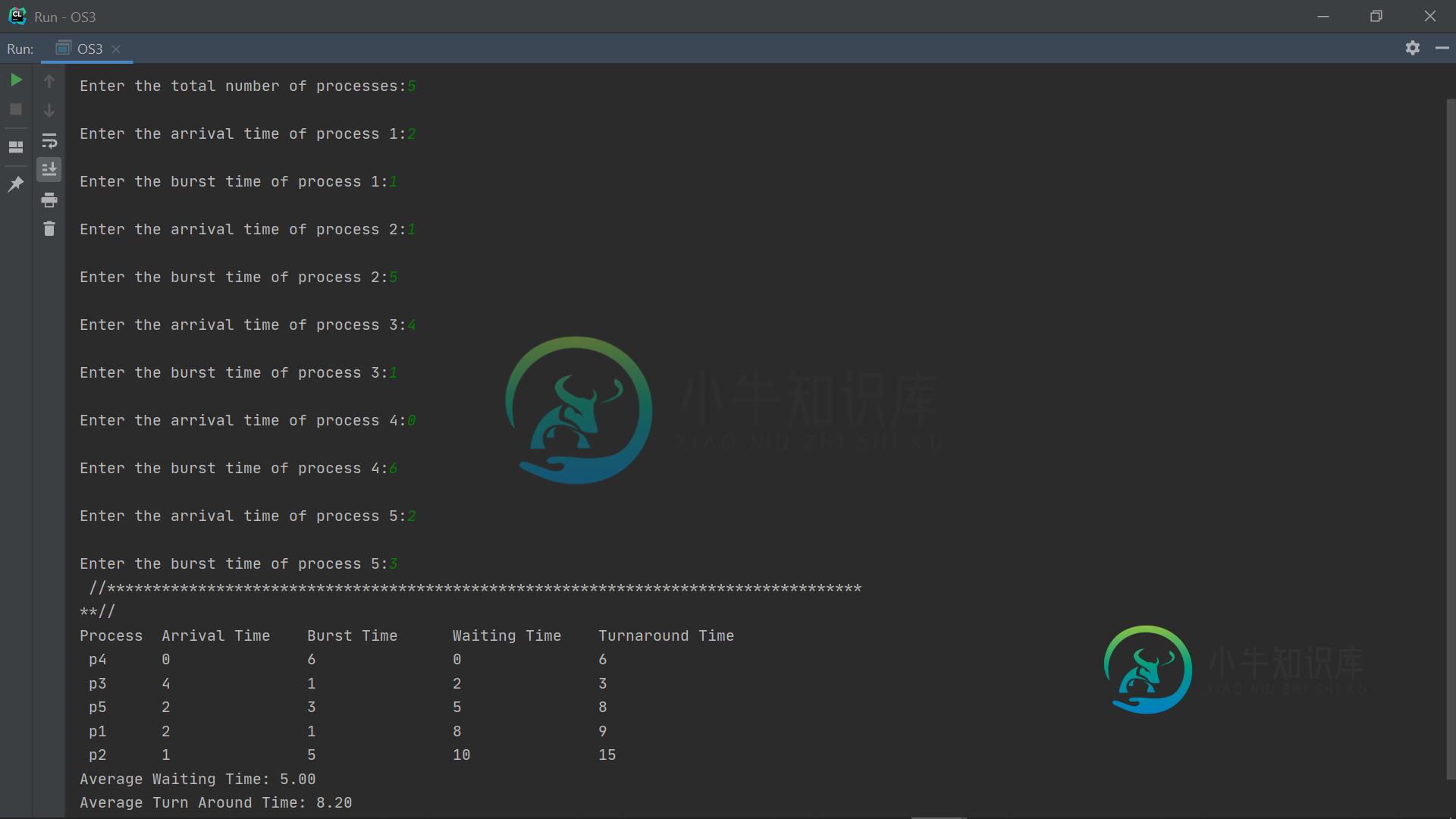C问题中最短作业优先调度算法
我已经创建了一个C程序来模拟非抢占式最短作业优先算法,但它在某些输入上有缺陷。最短作业优先算法程序接受所需数量的过程的到达和突发时间的输入,并将过程安排在两个阶段中。第一阶段涉及根据到达时间来安排节目,第二阶段根据突发时间来安排节目,假设它们的到达时间低于前一过程完成的时间。这一切最终都会被编译并显示出来。
#include <stdio.h>
// n - total processes
// p - process no. array
// bt - burst time array
// at - arrival time array
// wt - the time taken for the process to start from it's arrival time array
// tat - time spent by process in cpu array
int i, n, j, m, min, sum = 0, x = 1, btTally = 0, p[20], bt[20], at[20], wt[20], tat[20], ta = 0;
float tatTally = 0, wtTally = 0;
//function grabs arrival and burst times of each process and stores it in its respective array
void getInput(){
printf("\nEnter the total number of processes: ");
scanf("%d", & n);
// For Loop for user to input info about the processes
for (i = 0; i < n; i++) {
p[i] = i + 1;
printf("\nEnter the arrival time of process %d: ", p[i]);
scanf(" %d", & at[i]);
printf("\nEnter the burst time of process %d: ", p[i]);
scanf(" %d", & bt[i]);
}
}
//Function arranges processes according to their arrival times
void arrangePhase1(){
for (i = 0; i < n; i++) {
for (j = 0; j < n; j++) {
if (at[j] > at[i]) {
m = p[j];
p[j] = p[i];
p[i] = m;
m = at[j];
at[j] = at[i];
at[i] = m;
m = bt[j];
bt[j] = bt[i];
bt[i] = m;
}
}
}
}
//Function arranges the processes according to Burst time
void arrangePhase2(){
for (i = 0; i < n; i++) {
btTally = btTally + bt[i];
min = bt[x];
for (j = x; j < n; j++) {
if (bt[j] < min && btTally >= at[j]) {
m = p[x];
p[x] = p[j];
p[j] = m;
m = at[x];
at[x] = at[j];
at[j] = m;
m = bt[x];
bt[x] = bt[j];
bt[j] = m;
}
}
x++;
}
}
//Function calculates the tallies of turnaround time and waiting time
void calcTallies(){
for (i = 0; i < n; i++) {
ta = ta + bt[i];
tat[i] = ta - at[i];
tatTally = tatTally + tat[i];
}
wt[0] = 0;
for (i = 1; i < n; i++) {
sum = sum + bt[i - 1];
wt[i] = sum - at[i];
wtTally = wtTally + wt[i];
}
}
//Function displays all of the information about the algorithm running
void showFinal(){
printf("\nProcess\t Arrival Time\t Burst Time\t Waiting Time\t Turnaround Time");
for (i = 0; i < n; i++) {
printf("\n p%d\t %d\t\t %d\t\t %d\t\t %d", p[i], at[i], bt[i], wt[i], tat[i]);
}
printf("\nAverage Waiting Time: %.2f", (wtTally / n));
printf("\nAverage Turn Around Time: %.2f", (tatTally / n));
}
int main() {
getInput();
arrangePhase1();
arrangePhase2();
arrangePhase2();
calcTallies();
showFinal();
return 0;
}
这些是预期的结果:

这些是我通过我的程序获得的结果:

任何帮助都将不胜感激。谢谢!
共有1个答案
我。。。稍微重新排列一下您的程序...
#include <stdio.h>
#include <stdlib.h>
typedef struct {
int p, at, bt, wt, tat;
} Job;
#define maxN (20)
Job jobs[maxN ];
int n, btTally = 0, sum = 0, ta = 0;
float tatTally = 0, wtTally = 0;
#define TestSize (5)
Job Test[TestSize] = {
{ 1, 2, 1, 0, 0 },
{ 2, 1, 5, 0, 0 },
{ 3, 4, 1, 0, 0 },
{ 4, 0, 6, 0, 0 },
{ 5, 2, 3, 0, 0 }
};
void getInput(){
int i;
printf("\nEnter the total number of processes: ");
scanf("%d", & n);
if (n == 0) {
for (i = 0; i < TestSize; ++i)
jobs[i] = Test[i];
n = TestSize;
return;
}
// For Loop for user to input info about the processes
for (i = 0; i < n; i++) {
jobs[i].p = i + 1;
printf("\nEnter the arrival time of process %d: ", jobs[i].p);
scanf(" %d", & jobs[i].at);
printf("\nEnter the burst time of process %d: ", jobs[i].p);
scanf(" %d", & jobs[i].bt);
}
}
int compareAT (const void * a, const void * b) {
Job *jobA = (Job *)a;
Job *jobB = (Job *)b;
return ( jobA->at - jobB->at );
}
void arrangePhase1(){
qsort (jobs, n, sizeof(Job), compareAT);
}
void Swap(int i, int j) {
Job m = jobs[i];
jobs[i] = jobs[j];
jobs[j] = m;
}
void calcTallies(){
int i;
for (i = 0; i < n; i++) {
ta = ta + jobs[i].bt;
jobs[i].tat = ta - jobs[i].at;
tatTally = tatTally + jobs[i].tat;
}
jobs[0].wt = 0;
for (i = 1; i < n; i++) {
sum = sum + jobs[i - 1].bt;
jobs[i].wt = sum - jobs[i].at;
wtTally = wtTally + jobs[i].wt;
}
}
void showFinal(){
int i;
printf("\nProcess\t Arrival Time\t Burst Time\t Waiting Time\t Turnaround Time");
for (i = 0; i < n; i++) {
printf("\n p%d\t %d\t\t %d\t\t %d\t\t %d", jobs[i].p, jobs[i].at, jobs[i].bt, jobs[i].wt, jobs[i].tat);
}
printf("\nAverage Waiting Time: %.2f", (wtTally / n));
printf("\nAverage Turn Around Time: %.2f", (tatTally / n));
}
void arrangePhase2() {
int i, j, min, x = 1;
for (i = 0; i < n; i++) {
btTally = btTally + jobs[i].bt;
min = jobs[x].bt;
for (j = x; j < n; j++) {
if (jobs[j].bt < min && btTally >= jobs[j].at) {
Swap(x, j);
min = jobs[x].bt;
showFinal();
}
}
x++;
}
}
int main() {
getInput();
arrangePhase1();
showFinal();
arrangePhase2();
// arrangePhase2();
calcTallies();
showFinal();
return 0;
}
并在里面留下了一些测试和指纹。
主要问题是min未更新。尝试将更新添加到您的原始程序中,看看它是否有效。接下来是移动<code>int i,j到函数,它现在工作了吗?(如果只添加showFinal(),则没有它就无法工作
测试您的代码)。
现在我做的代码并不是唯一的真实事实,它只是一个几十年来没有编程过C的人的例子。
简短的代码回顾。在C中使用全局变量是不好的,如果您使用全局变量进行循环控制,您很容易遇到循环问题,这里i, j被大量重用。
您可以更多地使用结构,至少对于 3 个主要值,使一些排序更容易一些。在任何一种情况下,具有 Swap 函数都可以使代码更易于检查和理解。
void SwapInt(int *i, int *j) {
int m = *i;
*i = *j;
*j = m;
}
SwapInt(&at[i], &at[j]); // example of calling swapping
第二次调用<code>arrangePhase2()什么都不做。
-
假设以下进程在指定的时间到达执行。每个进程将运行列出的时间量。 我想绘制甘特图并计算抢占式最短作业优先调度的平均等待时间。 解决办法 http://imgur.com/fP8u61C 等待时间为2毫秒。 请告诉我这是否正确。 我怀疑的步骤是,在进程B到达的3ms时,调度程序是完成进程A还是启动进程B。
-
我熟悉最短进程下一个调度算法(SJF),它是一种非抢先算法。但是,该算法一次只能处理一个突发时间最小的进程。是否可以一次修改为“下一个最短流程2”? 所以对于这里提到的例子: 第一行表示进程总数。随后的行表示进程ID、到达时间、突发时间。 一次有两个流程的SJF计划将按如下方式工作: 这里 Idle表示当前有多少处理器空闲。在这种情况下,有2个处理器。可以观察到,在时间< code>t=4,有2个
-
所以我正在研究调度,包括FCFS和最短作业优先。我首先真的在纠结我最短的工作,我看不到我的逻辑错误。我把它打印出来,有些数字是正确的,但不是全部。我使用的测试文件包含以下文本: 我使用 任何帮助,指针或代码,将不胜感激! 编辑我认为我的问题是基于sfj函数的逻辑。对于输入,第一列是进程id,第二列是到达时间,第三列是突发时间或进程需要cpu多长时间。 我得到的输出是: 当我真正期望时:
-
到目前为止,我们根据它们的到达时间(在FCFS调度中)调度这些进程。 但是,SJF调度算法根据其突发时间安排进程。 在SJF调度中,就绪队列中可用进程列表中的突发时间最短的进程将在下一个进行调度。 然而,预测一个过程所需的突发时间是非常困难的,因此这个算法在系统中很难实现。 SJF的优势 最大吞吐量 最低的平均等候时间和周转时间 SJF的缺点 可能会面临饥饿问题 这是不可实现的,因为一个进程的确切
-
我正在尝试在java中编写CPU调度模拟器。进程按照顺序处理,因此应该首先处理具有最少突发时间(处理时间)的进程。在开始之前,我在ArrayList中输入所有进程,指定名称,突发时间 问题是进程有不同的到达时间。我如何编辑代码来考虑这个到达时间。 我只需要编辑代码的一部分,让我的进程具有最少的突发时间(相对于到达时间) 样本输出
-
我的目标是计算抢占最短作业优先调度算法的平均等待时间。 假设作业的到达时间以2个单位为间隔,如0,2,4,6……即,第一个作业以0个单位进入,第二个作业在2个单位的时间后进入,以此类推。 我为我的程序测试了 3 个测试用例并得到了正确答案: 测试用例1: 作业:8,4,9,5 平均时间:6.5 测试用例2: 作业:7,4,1,4 平均时间:3 但是当我把一个有1000个作业的文件作为输入时,我得到

